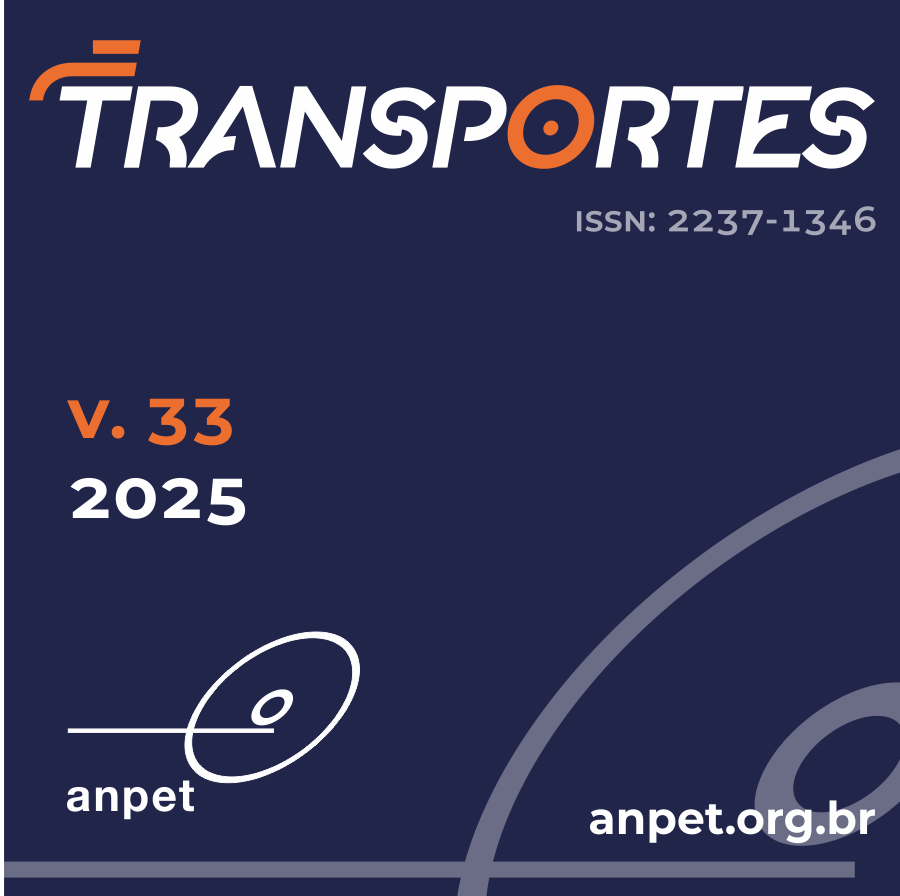Analysis of airport capacity utilization based on the daily distribution of operations
DOI:
https://doi.org/10.58922/transportes.v33.e3150Keywords:
Airport capacity. Operational efficiency. Slot regulation.Abstract
This study investigates the relationship between airport capacity expansion and the distribution of operations throughout the day, with an emphasis on the impact of slot allocation on operational efficiency. The analysis considers data from 26 Brazilian airports between 2019 and 2024, using indicators such as the Capacity Utilization Index (CUI) and the ratio between annual peak rate and installed hourly capacity. Through fixed effects panel data models, it was found that the increase in the number of passengers is the main factor associated with intensified infrastructure usage. Although capacity expansion has helped reduce pressure during peak hours, it has not significantly affected the redistribution of operations throughout the day. The results indicate that, in addition to infrastructure investments, there is a need to improve slot allocation mechanisms and consider demand stimulation policies during off-peak hours. The study reinforces the importance of coordinated management between infrastructure and regulation to ensure the efficient and sustainable use of Brazilian airports.
Downloads
References
Brasil, Agência Nacional de Aviação Civil (2025a) Arquivos (CSV/JSON) - Operador Aeroportuário: Dados de Movimentação Aeroportuária. Disponível em: <https://www.anac.gov.br/acesso-a-informacao/dados-abertos/areas-de-atuacao/operador-aeroportuario/dados-de-movimentacao-aeroportuaria> (acesso em 31/07/2025).
Brasil, Agência Nacional de Aviação Civil (2025b) Coordenação de Slots. Disponível em: <https://www.gov.br/anac/pt-br/assuntos/regulados/empresas-aereas/slot> (acesso em 31/07/2025).
Brasil, Ministério de Portos e Aeroportos (2025c) Com 9,56 milhões de passageiros transportados, a aviação civil brasileira registra a segunda maior movimentação da história para o mês. Ministério de Portos e Aeroportos. Disponível em: <https://www.gov.br/portos-e-aeroportos/pt-br/assuntos/noticias/2025/03/com-9-56-milhoes-de-passageiros-transportados-a-aviacao-civil-brasileira-registra-a-segunda-maior-movimentacao-da-historia-para-o-mes> (acesso em 31/07/2025).
CGNA (2025) Relatório Comparativo KPA Capacidade de Aeródromo: Janeiro de 2025. Rio de Janeiro. Disponível em: <https://portal.cgna.decea.mil.br/resources/> (acesso em 30/09/2025).
Dray, L. (2020) An empirical analysis of airport capacity expansion. Journal of Air Transport Management, v. 87, p. 101850. DOI: 10.1016/j.jairtraman.2020.101850. DOI: https://doi.org/10.1016/j.jairtraman.2020.101850
Fernandes, E. e R.R. Pacheco (2018) Managerial performance of airports in Brazil before and after concessions. Transportation Research Part A, Policy and Practice, v. 118, p. 245-57. DOI: 10.1016/j.tra.2018.09.003. DOI: https://doi.org/10.1016/j.tra.2018.09.003
Gelhausen, M.C.; P. Berster e D. Wilken (2013) Do airport capacity constraints have a serious impact on the future development of air traffic. Journal of Air Transport Management, v. 28, p. 3-13. DOI: 10.1016/j.jairtraman.2012.12.004. DOI: https://doi.org/10.1016/j.jairtraman.2012.12.004
HÓRUS (2025) Ministério de Portos e Aeroportos, Secretaria Nacional de Aviação Civil. Disponível em: <https://horus.labtrans.ufsc.br/gerencial/#Movimentacaoo/DadosCompletos> (acesso em 31/07/2025).
ICAO (2021) Effects of Novel Coronavirus on Civil Aviation: Economic Impact Analysis. Montréal: ICAO. Disponível em: <https://www.icao.int/sustainability/Documents/COVID-19/ICAO_Coronavirus_Econ_Impact.pdf> (acesso em 31/07/2025).
Katsigiannis, F.A. e K.G. Zografos (2023) Multi-objective airport slot scheduling incorporating operational delays and multi-stakeholder preferences. Transportation Research Part C, Emerging Technologies, v. 152, n. 104156, p. 104156. DOI: 10.1016/j.trc.2023.104156. DOI: https://doi.org/10.1016/j.trc.2023.104156
Madas, M.A. e K.G. Zografos (2006) Airport slot allocation: from instruments to strategies. Journal of Air Transport Management, v. 12, n. 2, p. 53-62. DOI: 10.1016/j.jairtraman.2005.08.001. DOI: https://doi.org/10.1016/j.jairtraman.2005.08.001
Mello, F.P.; F.G.F. Silva e V. Falcão (2025) Renegotiation drivers in Brazilian airport concessions. Transport Policy, v. 169, p. 116-32. DOI: 10.1016/j.tranpol.2025.03.030. DOI: https://doi.org/10.1016/j.tranpol.2025.03.030
Oum, T.H.; J. Yan e C. Yu (2008) Ownership forms matter for airport efficiency: a stochastic frontier investigation of worldwide airports. Journal of Urban Economics, v. 64, n. 2, p. 422-35. DOI: 10.1016/j.jue.2008.03.001. DOI: https://doi.org/10.1016/j.jue.2008.03.001
Picard, P.M.; A. Tampieri e X. Wan (2019) Airport capacity and inefficiency in slot allocation. International Journal of Industrial Organization, v. 62, p. 330-57. DOI: 10.1016/j.ijindorg.2017.10.003. DOI: https://doi.org/10.1016/j.ijindorg.2017.10.003
Ren, J.; S. Qu; L. Wang et al. (2025) A flight slot optimization model for Beijing-Tianjin-Hebei airport cluster considering capacity fluctuation factor. Aerospace, v. 12, n. 4, p. 336. DOI: 10.3390/aerospace12040336. DOI: https://doi.org/10.3390/aerospace12040336
Ritchie, H. (2024) What Share of Global CO2 Emissions Come from Aviation? Disponível em: <https://ourworldindata.org/global-aviation-emissions#article-citation> (acesso em 31/07/2025).
Tasca, A.L.; V. Cipolla; K. Abu Salem et al. (2021) Innovative box-wing aircraft: emissions and climate change. Sustainability, v. 13, n. 6, p. 3282. DOI: 10.3390/su13063282. DOI: https://doi.org/10.3390/su13063282
Wang, Y.; M. Wang; W. Xu et al. (2023) Secondary trading of airport slots: issues and challenges. Chinese Journal of Aeronautics, v. 36, n. 12, p. 1-12. DOI: 10.1016/j.cja.2023.07.004. DOI: https://doi.org/10.1016/j.cja.2023.07.004
Wang, Y. e Y. Ni (2025) Airport slot allocation with low-carbon consideration. Transportation Research, v. 196, p. 104009. DOI: 10.1016/j.tre.2025.104009. DOI: https://doi.org/10.1016/j.tre.2025.104009
Zeng, W.; C. Xu; X. Shu et al. (2025) A novel slot optimization model for congested airports integrating IATA priority and operational priority. Journal of Air Transport Management, v. 124, p. 102751. DOI: 10.1016/j.jairtraman.2025.102751. DOI: https://doi.org/10.1016/j.jairtraman.2025.102751
Zografos, K.G.; K.N. Androutsopoulos e M.A. Madas (2018) Minding the gap: optimizing airport schedule displacement and acceptability. Transportation Research, v. 114, p. 203-21. DOI: https://doi.org/10.1016/j.tra.2017.09.025
Downloads
Published
How to Cite
Issue
Section
License
Copyright (c) 2025 Marcos André Lira Silva, Viviane Falcão

This work is licensed under a Creative Commons Attribution 4.0 International License.
Authors who submit papers for publication by TRANSPORTES agree to the following terms:
- The authors retain the copyright and grant Transportes the right of first publication of the manuscript, without any financial charge, and waive any other remuneration for its publication by ANPET.
- Upon publication by Transportes, the manuscript is automatically licensed under the Creative Commons License CC BY 4.0 license. This license permits the work to be shared with proper attribution to the authors and its original publication in this journal.
- Authors are authorized to enter into additional separate contracts for the non-exclusive distribution of the version of the manuscript published in this journal (e.g., publishing in an institutional repository or as a book chapter), with recognition of the initial publication in this journal, provided that such a contract does not imply an endorsement of the content of the manuscript or the new medium by ANPET.
- Authors are permitted and encouraged to publish and distribute their work online (e.g., in institutional repositories or on their personal websites) after the editorial process is complete. As Transportes provides open access to all published issues, authors are encouraged to use links to the DOI of their article in these cases.
- Authors guarantee that they have obtained the necessary authorization from their employers for the transfer of rights under this agreement, if these employers hold any copyright over the manuscript. Additionally, authors assume all responsibility for any copyright infringements by these employers, releasing ANPET and Transportes from any responsibility in this regard.
- Authors assume full responsibility for the content of the manuscript, including the necessary and appropriate authorizations for the disclosure of collected data and obtained results, releasing ANPET and Transportes from any responsibility in this regard.










